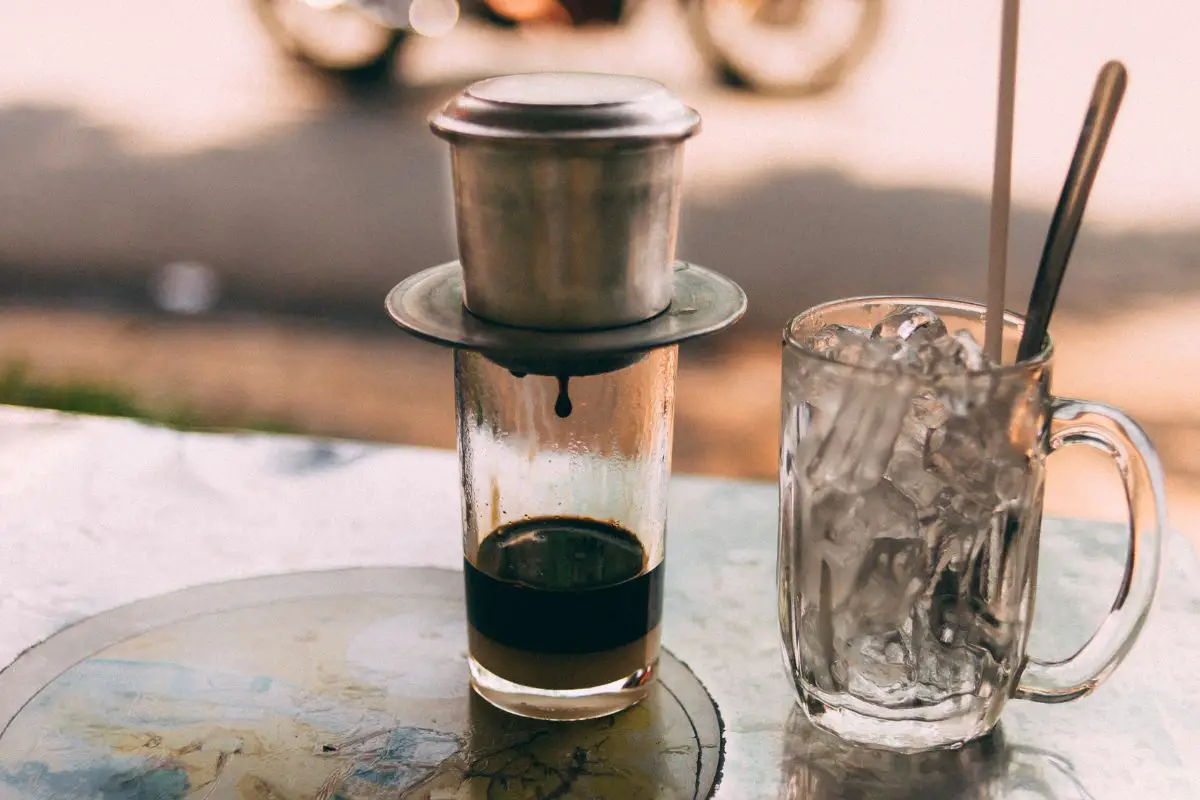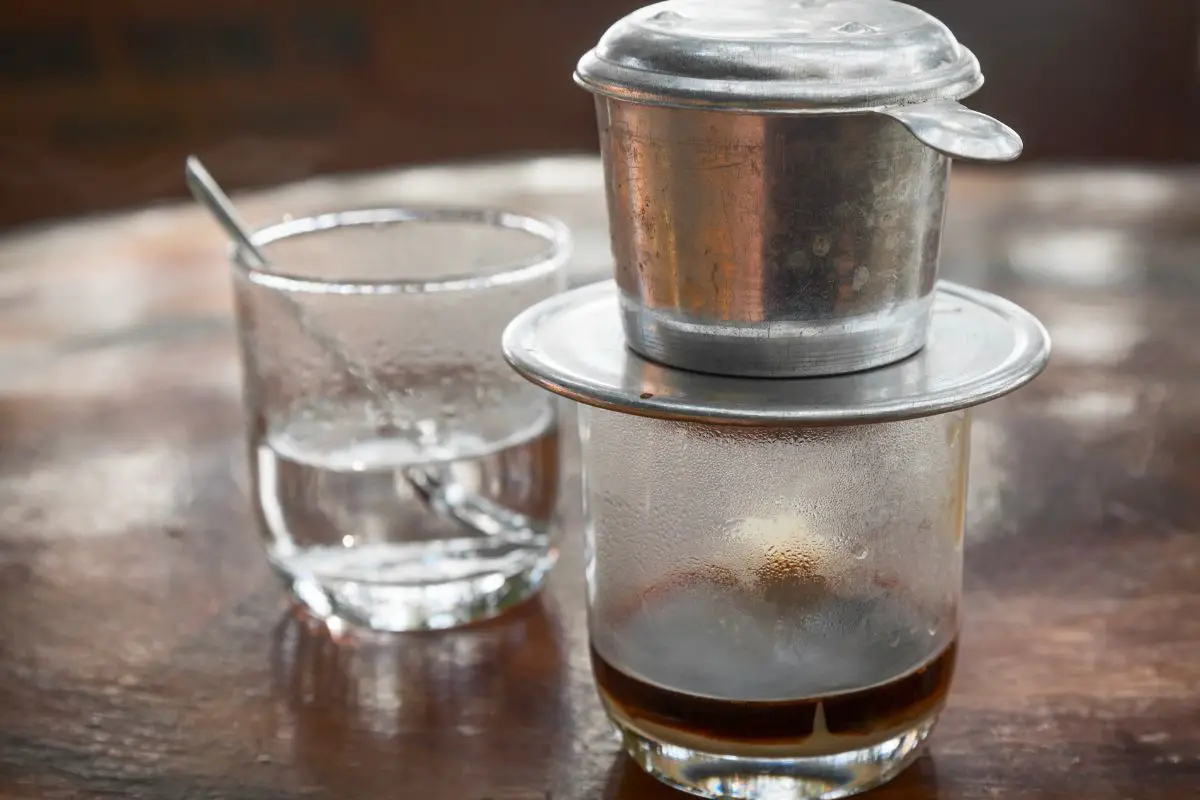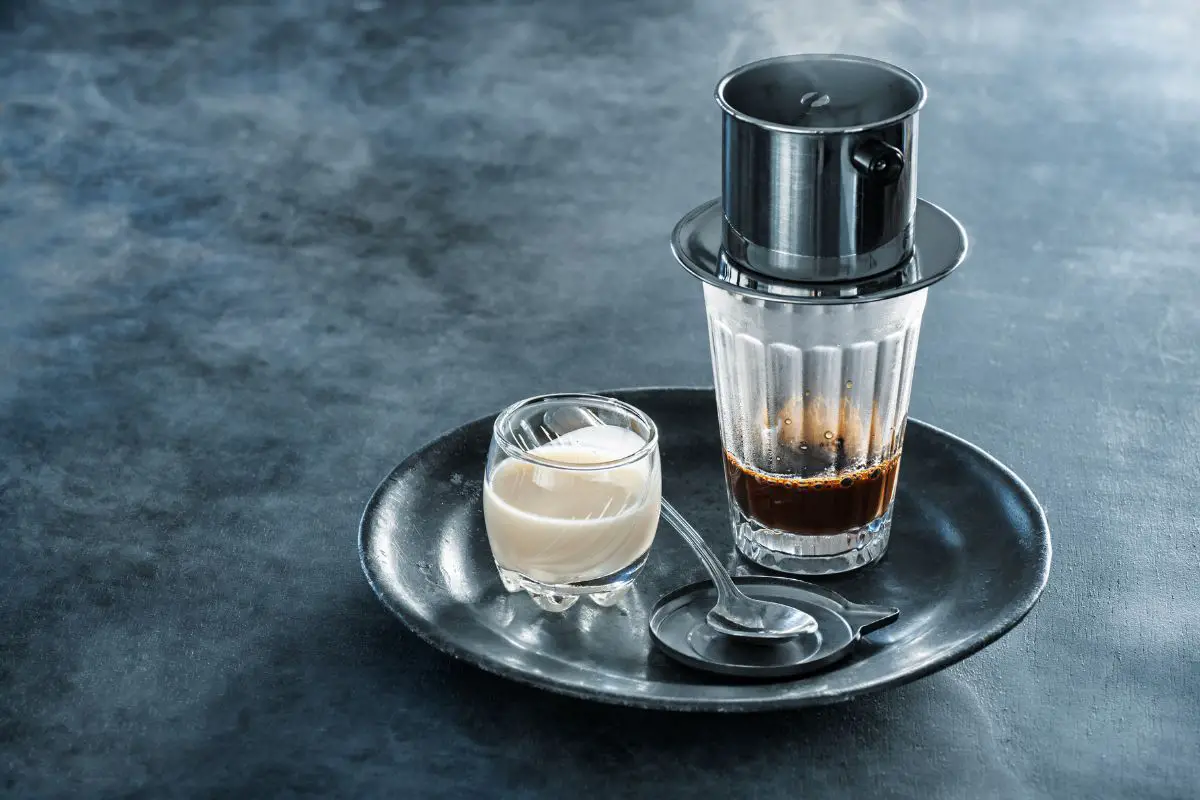In the world of coffee, two distinct brewing traditions stand out: Vietnamese coffee and regular coffee. Like two contrasting symphonies, each offers a unique composition of flavors, brewing techniques, and cultural significance.

Vietnamese coffee, with its bold and rich taste, is a harmonious blend of dark roasted beans and sweetened condensed milk.
In contrast, regular coffee, known for its more traditional flavors, is brewed using various methods and consumed in its purest form.
This article delves into the intricate details of Vietnamese coffee versus regular coffee, exploring the brewing techniques, taste profiles, cultural significance, ingredient differences, serving styles, and potential health benefits of each.
By analyzing these aspects, coffee enthusiasts can gain a comprehensive understanding of the distinct characteristics of each brew, allowing them to make informed choices and embark on a journey of sensory exploration.
So, grab your cup of coffee and let’s delve into the world of Vietnamese coffee versus regular coffee.
Key Takeaways
- Vietnamese coffee and regular coffee are two distinct brewing traditions with unique flavors, brewing techniques, and cultural significance.
- Vietnamese coffee is known for its bold and rich taste, achieved by blending dark roasted beans with sweetened condensed milk.
- Vietnamese coffee is brewed using a phin filter and a slow drip process, resulting in a strong and concentrated brew.
- Regular coffee, on the other hand, has a milder taste with balanced acidity and a smoother mouthfeel, often attributed to the use of Arabica beans and quicker extraction methods.
Brewing Techniques: Explore the unique brewing methods of Vietnamese coffee
This section aims to delve into the distinct brewing techniques employed in Vietnamese coffee preparation, offering an insightful exploration of its unique methodology and practices.
Vietnamese coffee brewing typically involves the use of a phin filter, which is a small metal chamber that sits directly on top of a cup or mug. The filter is filled with finely ground coffee, and hot water is poured over it. The coffee then slowly drips into the cup, resulting in a strong and concentrated brew.
One key aspect of Vietnamese coffee brewing is the use of condensed milk as a sweetener and flavor enhancer. The condensed milk is added to the cup before the coffee drips into it, allowing it to mix with the coffee as it brews. This gives Vietnamese coffee its signature creamy and slightly sweet taste.
Another unique aspect of Vietnamese coffee brewing is the option to control the strength of the brew. By adjusting the amount of coffee grounds and the brewing time, individuals can customize their coffee to their preferred strength.
In contrast to regular coffee brewing methods, Vietnamese coffee preparation takes a bit longer due to the slow drip process. However, this extra time allows the coffee to develop a bold and robust flavor profile.
Transition: Moving on to taste profiles, Vietnamese coffee offers a distinctly bold and rich experience compared to the more traditional flavors of regular coffee.
Taste Profiles: Compare the bold and rich flavors of Vietnamese coffee to the more traditional flavors of regular coffee
Contrasting the robust and intense flavor profiles of Vietnamese coffee with the more conventional tastes found in the classic brew, one can observe a stark disparity akin to night and day.
Vietnamese coffee is known for its bold and rich flavors, which are derived from a unique combination of factors. Firstly, the coffee beans used are often of the Robusta variety, which have a higher caffeine content and a stronger taste compared to the Arabica beans commonly used in regular coffee. Additionally, the brewing method plays a crucial role in enhancing the flavors of Vietnamese coffee. The use of a Phin filter creates a slow and steady extraction process, allowing the coffee to steep for a longer period and resulting in a more concentrated and flavorful cup. The addition of sweetened condensed milk further enhances the taste, adding a creamy and caramel-like sweetness that complements the strong coffee flavors.
In contrast, regular coffee tends to have a milder taste, with a balanced acidity and a smoother mouthfeel. This is often attributed to the use of Arabica beans, which have a more nuanced and delicate flavor profile. The brewing techniques for regular coffee also vary, with methods such as drip brewing and French press being commonly used. These methods result in a quicker extraction process, producing a lighter and less concentrated cup of coffee.
In summary, Vietnamese coffee offers a bold and intense flavor experience, while regular coffee provides a more conventional and balanced taste.
Transitioning into the subsequent section about the cultural significance of Vietnamese coffee, one can delve into the rich traditions and rituals associated with this beloved beverage.
Cultural Significance: Learn about the cultural importance and rituals associated with Vietnamese coffee

Transitioning into the subsequent section about the cultural significance of Vietnam’s beloved beverage, one can explore the deep-rooted traditions and ceremonial aspects surrounding the consumption of this flavorful elixir. Vietnamese coffee holds a special place in the hearts and daily routines of its people. It is not only a drink but also a social activity that brings people together. To fully understand its cultural importance, it is essential to delve into the rituals associated with Vietnamese coffee.
A 3-column, 3-row table can help illustrate the cultural significance of Vietnamese coffee:
| Rituals and Traditions | Description | Purpose |
|---|---|---|
| Making the Coffee | Vietnamese coffee is traditionally made using a small metal filter called a phin. This slow brewing process allows for a strong and rich flavor to develop. | To savor the aroma and taste of the coffee while engaging in a mindful and meditative practice. |
| Serving with Condensed Milk | Vietnamese coffee is often served with a layer of condensed milk at the bottom of the cup. The slow drip of coffee blends with the sweet milk, creating a unique flavor profile. | To balance the strong bitterness of the coffee and provide a touch of sweetness. |
| Enjoying with Friends | Vietnamese coffee is often enjoyed in a social setting, where friends gather at coffee shops or homes to chat, relax, and bond over a cup of aromatic coffee. | To foster social connections and build relationships within the community. |
These rituals and traditions associated with Vietnamese coffee highlight its cultural significance and the importance of the beverage in Vietnamese society.
Transitioning into the subsequent section about ingredient differences: examine the types of beans and additives used in Vietnamese coffee compared to regular coffee, one can explore the distinct characteristics that contribute to the unique flavor profiles of each type of coffee.
Ingredient Differences: Examine the types of beans and additives used in Vietnamese coffee compared to regular coffee
Examining the types of beans and additional ingredients used in Vietnamese coffee compared to the conventional counterpart provides insight into the distinct elements that contribute to the unique flavor profiles of each variant.
Vietnamese coffee is typically made using robusta beans, which have a stronger and more bitter taste compared to the arabica beans commonly used in regular coffee. The robusta beans give Vietnamese coffee its characteristic bold and intense flavor.
In addition to the beans, Vietnamese coffee often includes additives such as condensed milk or egg yolks, which add a creamy and sweet element to the drink. This combination of robusta beans and creamy additives creates a rich and indulgent flavor experience.
Regular coffee, on the other hand, is often made using arabica beans, which have a more delicate and nuanced flavor compared to robusta beans. The use of arabica beans results in a smoother and less bitter taste in regular coffee. Regular coffee is typically consumed black or with the addition of milk or sugar, depending on individual preferences.
The types of beans and additives used in Vietnamese coffee contribute to its distinct and robust flavor profile, while regular coffee offers a more delicate and versatile taste. Understanding these differences can enhance one’s appreciation for the unique characteristics of each variant.
Moving on to the next section, we will explore the different ways that Vietnamese coffee is served, including variations with condensed milk or over ice.
Serving Styles: Discover the different ways Vietnamese coffee is served, such as with condensed milk or over ice
Served in various styles, Vietnamese coffee captivates with its versatility, offering options such as the velvety sweetness of condensed milk or the refreshing chill of an iced concoction. This unique way of serving the beverage adds a distinct flavor profile and texture, setting it apart from regular coffee.
To help you appreciate the different serving styles of Vietnamese coffee, the following table provides a comparison:
| Vietnamese Coffee | Regular Coffee |
|---|---|
| Served with | Typically enjoyed |
| condensed milk | black or with milk |
| and sugar | |
| Often served over | Usually enjoyed |
| ice | hot |
| Intense flavor | Rich and balanced |
| profile | flavor profile |
Vietnamese coffee is often brewed using a traditional drip filter called a “phin,” which produces a strong and robust brew. The addition of condensed milk adds a luscious sweetness that complements the coffee’s bold flavors. On the other hand, regular coffee is commonly brewed using various methods such as drip brewing or espresso machines, resulting in a milder taste.
Transitioning into the subsequent section about health benefits, it is important to explore the potential health benefits and drawbacks of both Vietnamese coffee and regular coffee.
Health Benefits: Explore the potential health benefits and drawbacks of both Vietnamese coffee and regular coffee

When considering the health benefits of both traditional Vietnamese coffee and regular coffee, it is important to delve into the potential advantages and disadvantages of each.
Regular coffee, which is typically brewed using a drip method, has been extensively studied for its health effects. It contains caffeine, a natural stimulant that provides a temporary boost in energy and alertness. Additionally, regular coffee is rich in antioxidants, which have been linked to a reduced risk of chronic diseases such as heart disease and certain types of cancer.
On the other hand, Vietnamese coffee, often made using a phin filter and served with condensed milk, offers a unique flavor profile. However, it is important to note that condensed milk is high in sugar and calories, which may contribute to weight gain and an increased risk of chronic diseases such as diabetes and obesity. Additionally, the high caffeine content in Vietnamese coffee may lead to adverse effects such as insomnia, jitteriness, and increased heart rate in some individuals.
Regular coffee offers potential health benefits such as increased alertness and antioxidant protection. However, it is crucial to consume it in moderation and without added sugars or creamers to fully reap its health benefits.
Vietnamese coffee, while enjoyable, should be consumed with caution due to its high sugar and calorie content.
Ultimately, individuals should consider their overall dietary patterns and health goals when deciding between these two types of coffee.
Frequently Asked Questions
What are some unique brewing techniques used in Vietnamese coffee?
One unique brewing technique in Vietnamese coffee is the use of a phin filter, which allows for a slow and controlled extraction process. This method enhances the flavor and aroma of the coffee, creating a rich and satisfying experience for the drinker.
How do the taste profiles of Vietnamese coffee compare to regular coffee?
Vietnamese coffee has a distinct taste profile compared to regular coffee. It is known for its strong and bold flavor, often described as rich, dark, and slightly sweet. Regular coffee, on the other hand, varies in taste depending on factors such as origin, roast level, and brewing method.
What is the cultural significance of Vietnamese coffee, and are there any rituals associated with it?
Vietnamese coffee holds cultural significance in Vietnam and is often consumed as part of daily life. It is associated with rituals such as slow brewing using a phin filter and the traditional practice of sipping and enjoying the coffee leisurely.
What are the differences in the types of beans and additives used in Vietnamese coffee compared to regular coffee?
The types of beans used in Vietnamese coffee differ from regular coffee, as they often use Robusta beans instead of Arabica. Additionally, Vietnamese coffee may include additives like condensed milk, giving it a unique flavor and texture.
How is Vietnamese coffee typically served, and are there any specific serving styles or traditions associated with it?
Vietnamese coffee is typically served in a small cup with a drip filter on top. It is often enjoyed slowly, allowing the strong and rich flavors to develop. There are no specific serving styles or traditions associated with it.
Conclusion
In conclusion, this article has provided an informative and detailed comparison between Vietnamese coffee and regular coffee.
By exploring brewing techniques, taste profiles, cultural significance, ingredient differences, serving styles, and health benefits, readers can gain a deeper understanding of the unique qualities and characteristics of Vietnamese coffee.
Whether one prefers the bold and rich flavors of Vietnamese coffee or the more traditional flavors of regular coffee, understanding the differences and cultural significance can enhance the enjoyment of these beverages.
Related articles:
How to Make Vietnamese Coffee?
What Is the Difference between Colombian Roast and Regular Coffee?